
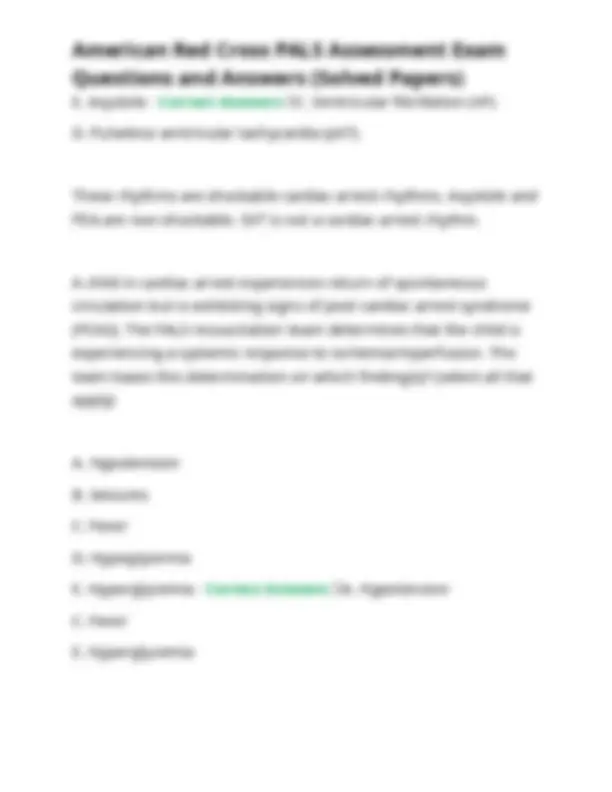

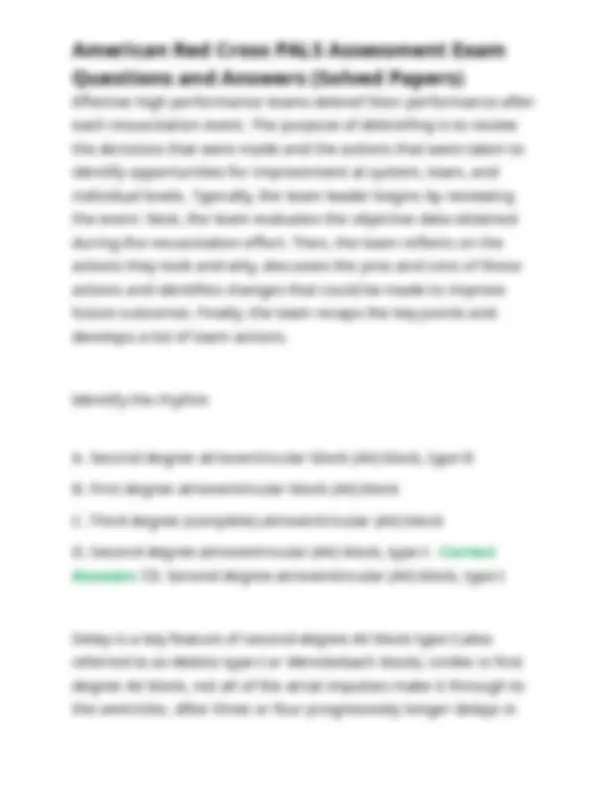
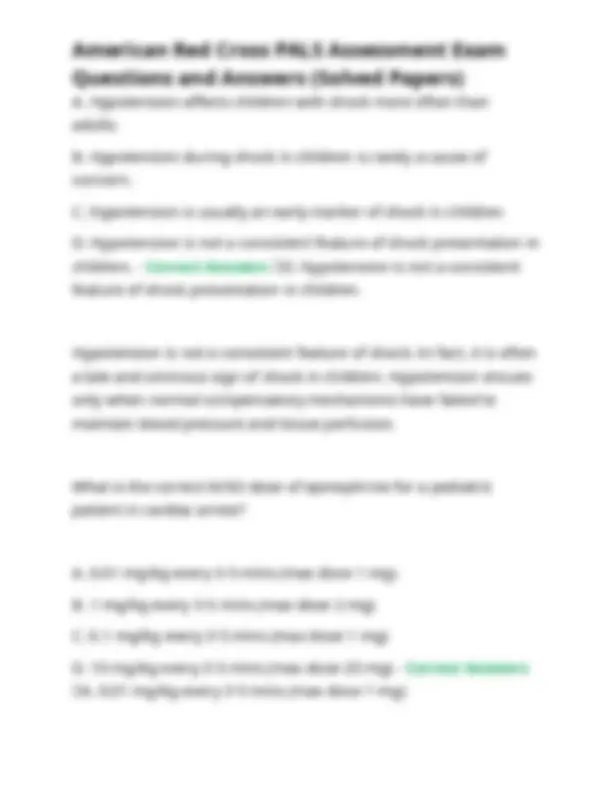
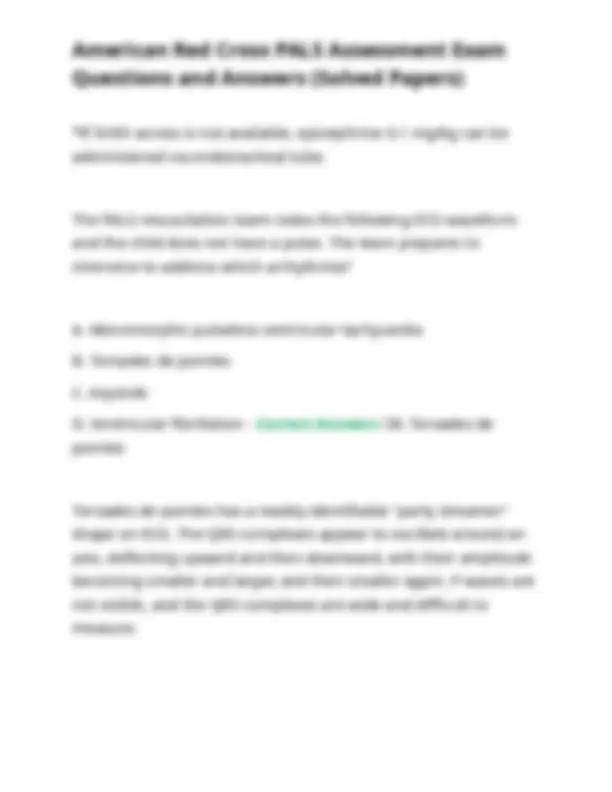
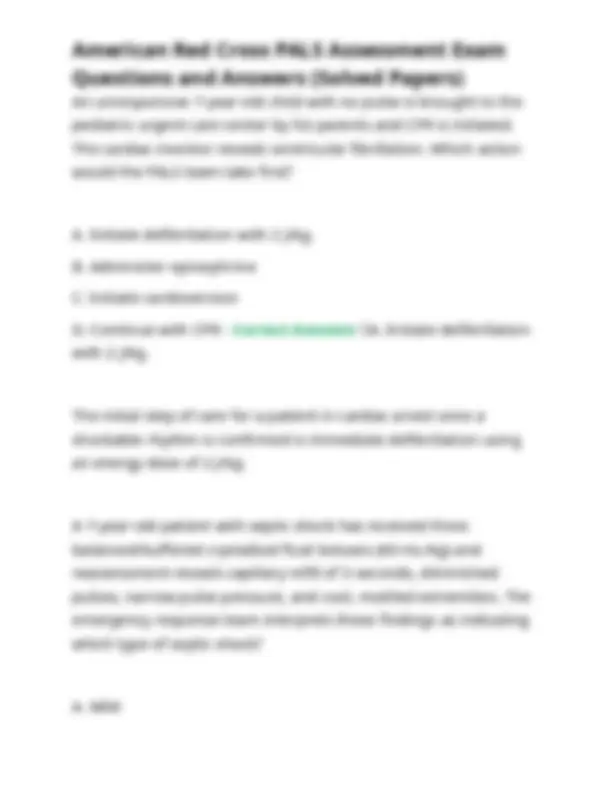
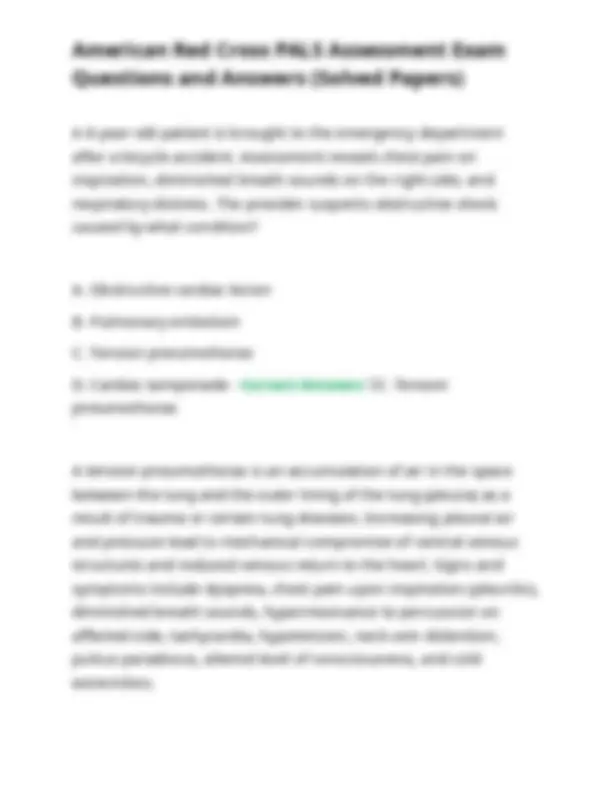
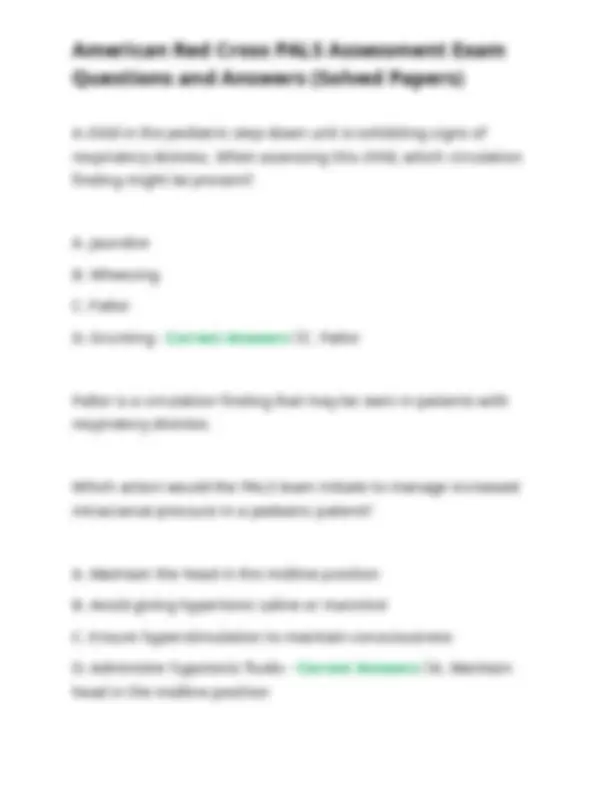
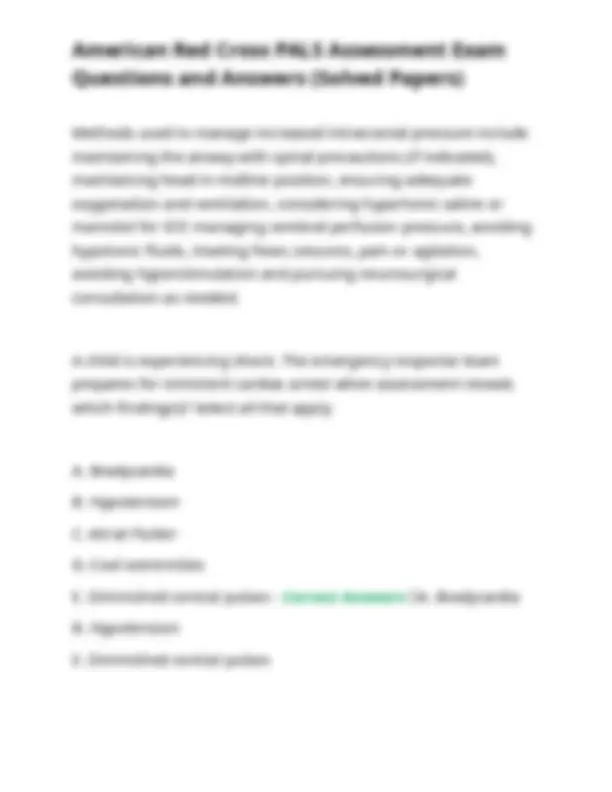


Study with the several resources on Docsity

Earn points by helping other students or get them with a premium plan


Prepare for your exams
Study with the several resources on Docsity

Earn points to download
Earn points by helping other students or get them with a premium plan
Community
Ask the community for help and clear up your study doubts
Discover the best universities in your country according to Docsity users
Free resources
Download our free guides on studying techniques, anxiety management strategies, and thesis advice from Docsity tutors
American Red Cross PALS Assessment Exam Questions and Answers (Solved Papers)
Typology: Exams
1 / 17

This page cannot be seen from the preview
Don't miss anything!










A provider is forming an initial impression of a child using the Pediatric Assessment Triangle (PAT). For which part of the PAT may the provider use the mnemonic TICLS to assess the patient? A. Appearance B. Work of breathing C. Circulation D. Exposure - Correct Answers ✅A. Appearance To form the initial impression of the patient's condition, follow the Pediatric Assessment Triangle (PAT), which uses a sequential A-B-C (appearance, work of breathing, circulation) approach. During the appearance assessment of the PAT, the provider may use the mnemonic TICLS to assess the patient. TICLS stands for tone, interactivity, consolability, look/gaze, speech/cry). A 7-year-old child collapses on the playground at school. The school nurse is called to the scene and determines the child is unresponsive and is not breathing and has no pulse. The nurse initiates CPR. At what rate and depth would the nurse deliver compressions to this child?
A. 100 to 120 compressions per minute and a depth of about 1. inches B. 120 to 140 compressions per minute and a depth of about 1. inches C. 100 to 120 compressions per minute at a depth of about 2 inches D. 120 to 140 compressions per minute at a depth of about 2 inches - Correct Answers ✅C. 100 to 120 compressions per minute at a depth of about 2 inches For children and infants, provide compressions at a rate of 100 to 120 per minute. For children, compress to a depth of about 2 inches. For an infant, compress to a depth of about 1.5 inches. A PALS resuscitation team is preparing to defibrillate a child experiencing cardiac arrest. For which rhythm(s) would this action be appropriate? (Select all that apply) A. Pulseless electrical activity (PEA) B. Supraventricular tachycardia (SVT) C. Ventricular fibrillation (VF) D. Pulseless ventricular tachycardia (pVT)
Systemic response to ischemia/reperfusion reflects impaired tissue oxygenation causing systemic inflammation, vascular instability, and increased coagulation along with adrenal suppression and a lowered resistance to infection. Clinical manifestations include fever, hypotension, hyperglycemia, infection, multiorgan failure. The PALS team leader is conducting a debriefing session with the team. Which topic(s) would the team leader most likely address during the session? A. Identification of ways to improve B. Summary of the event, including what actions were taken C. Recommendation of methods to decrease resuscitation time D. Discussion of the pros and cons of the interventions E. Evaluation of the objective data gathered during the event - Correct Answers ✅A. Identification of ways to improve B. Summary of the event, including what actions were taken D. Discussion of the pros and cons of the interventions E. Evaluation of the objective data gathered during the event
Effective high performance teams debrief their performance after each resuscitation event. The purpose of debriefing is to review the decisions that were made and the actions that were taken to identify opportunities for improvement at system, team, and individual levels. Typically, the team leader begins by reviewing the event. Next, the team evaluates the objective data obtained during the resuscitation effort. Then, the team reflects on the actions they took and why, discusses the pros and cons of those actions and identifies changes that could be made to improve future outcomes. Finally, the team recaps the key points and develops a list of team actions. Identify the rhythm A. Second degree atrioventricular block (AV) block, type II B. First degree atrioventricular block (AV) block C. Third degree (complete) atrioventricular (AV) block D. Second degree atrioventricular (AV) block, type I - Correct Answers ✅D. Second degree atrioventricular (AV) block, type I Delay is a key feature of second-degree AV block type I (also referred to as Mobitz type I or Wenckebach block). Unlike in first degree AV block, not all of the atrial impulses make it through to the ventricles. After three or four progressively longer delays in
While performing a rapid assessment and formulating an initial impression using the Pediatric Assessment Triangle (PAT), the provider assesses the child's circulation. Which information would be important to consider? Select all that apply. A. Accessory muscle use B. Skin pallor C. Flushing of the skin D. Evidence of bleeding E. Nasal flaring - Correct Answers ✅B. Skin pallor C. Flushing of the skin D. Evidence of bleeding When assessing the adequacy of circulation, consider skin color and visible mucous membranes for pallor, cyanosis, mottling or flushing and evidence of any bleeding, including life-threatening bleeding. A provider is assessing a child with suspected shock. Which statement correctly describes hypotension and shock?
A. Hypotension affects children with shock more often than adults. B. Hypotension during shock in children is rarely a cause of concern. C. Hypotension is usually an early marker of shock in children D. Hypotension is not a consistent feature of shock presentation in children. - Correct Answers ✅D. Hypotension is not a consistent feature of shock presentation in children. Hypotension is not a consistent feature of shock. In fact, it is often a late and ominous sign of shock in children. Hypotension ensues only when normal compensatory mechanisms have failed to maintain blood pressure and tissue perfusion. What is the correct IV/IO dose of epinephrine for a pediatric patient in cardiac arrest? A. 0.01 mg/kg every 3-5 mins (max dose 1 mg) B. 1 mg/kg every 3-5 mins (max dose 2 mg) C. 0.1 mg/kg every 3-5 mins (max dose 1 mg) D. 10 mg/kg every 3-5 mins (max dose 20 mg) - Correct Answers ✅A. 0.01 mg/kg every 3-5 mins (max dose 1 mg)
An unresponsive 7-year-old child with no pulse is brought to the pediatric urgent care center by his parents and CPR is initiated. The cardiac monitor reveals ventricular fibrillation. Which action would the PALS team take first? A. Initiate defibrillation with 2 J/kg. B. Administer epinephrine C. Initiate cardioversion D. Continue with CPR - Correct Answers ✅A. Initiate defibrillation with 2 J/kg. The initial step of care for a patient in cardiac arrest once a shockable rhythm is confirmed is immediate defibrillation using an energy dose of 2 J/kg. A 7-year-old patient with septic shock has received three balanced/buffered crystalloid fluid boluses (60 mL/kg) and reassessment reveals capillary refill of 3 seconds, diminished pulses, narrow pulse pressure, and cool, mottled extremities. The emergency response team interprets these findings as indicating which type of septic shock? A. Mild
B. Hypertensive C. Fluid-refractory D. Fluid-responsive - Correct Answers ✅C. Fluid-refractory Septic shock that does not respond to fluid therapy is called fluid- refractory septic shock. A 30-month-old child has been diagnosed with moderate croup. Which medication(s) would the provider administer? Choose all that apply. A. Nebulized epinephrine B. Corticosteroids C. Diuretics D. Antibiotics E. Albuterol - Correct Answers ✅A. Nebulized epinephrine B. Corticosteroids The child is exhibiting signs of moderate croup. Therefore, nebulized epinephrine and corticosteroids are indicated. Administration of nebulized epinephrine reduces inflammation
A 6-year-old patient is brought to the emergency department after a bicycle accident. Assessment reveals chest pain on inspiration, diminished breath sounds on the right side, and respiratory distress. The provider suspects obstructive shock caused by what condition? A. Obstructive cardiac lesion B. Pulmonary embolism C. Tension pneumothorax D. Cardiac tamponade - Correct Answers ✅C. Tension pneumothorax A tension pneumothorax is an accumulation of air in the space between the lung and the outer lining of the lung (pleura) as a result of trauma or certain lung diseases. Increasing pleural air and pressure lead to mechanical compromise of central venous structures and reduced venous return to the heart. Signs and symptoms include dyspnea, chest pain upon inspiration (pleuritic), diminished breath sounds, hyperresonance to percussion on affected side, tachycardia, hypotension, neck vein distention, pulsus paradoxus, altered level of consciousness, and cold extremities.
A child in the pediatric step-down unit is exhibiting signs of respiratory distress. When assessing this child, which circulation finding might be present? A. Jaundice B. Wheezing C. Pallor D. Grunting - Correct Answers ✅C. Pallor Pallor is a circulation finding that may be seen in patients with respiratory distress. Which action would the PALS team initiate to manage increased intracranial pressure in a pediatric patient? A. Maintain the head in the midline position B. Avoid giving hypertonic saline or mannitol C. Ensure hyperstimulation to maintain consciousness D. Administer hypotonic fluids - Correct Answers ✅A. Maintain head in the midline position
Shock can become irreversible when damage to key organs cannot be undone even if adequate cardiovascular function is restored. Potential signs forewarning imminent cardiac arrest in a child in shock include hypotension, bradycardia, and diminished central pulses. An 8-year-old child being treated in the ED has significant respiratory distress. The child also exhibits hives, wheezing, angioedema, tachycardia, and dyspnea. The parents state that the child, who is allergic to peanuts, had eaten some popcorn with peanuts in it. The team initiates care, preparing to administer which agent first? A. Epinephrine B. Phenylephrine C. Diphenhydramine D. Methylprednisolone - Correct Answers ✅A. Epinephrine Immediate management of anaphylactic shock consists of fluid resuscitation and administration of epinephrine to counteract the vasodilation that is characteristic pathophysiology of this type of shock. Refractory hypotension may be treated with agents that increase systemic vascular resistance (SVR) such as
norepinephrine or phenylephrine. Antihistamines and steroids may impede the release of mediators that contribute to the pathogenesis of anaphylaxis and may thus help to reverse symptoms.